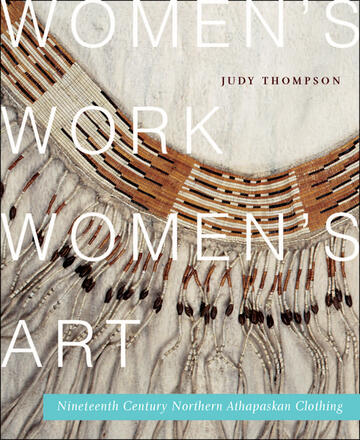
Women's Work, Women's Art
Nineteenth-Century Northern Athapaskan Clothing
Description
Garments made from tanned animal hides afforded Northern Athapaskans protection against a harsh northern environment, but the striking features of this clothing are also a distinctive part of the traditional culture of the Indigenous peoples of North America's western subarctic. Beautifully decorated with quillwork, fringes, and pigments, they provide a means of artistic expression signifying ethnic identity and conveying information about the physical, social, and spiritual well-being of the wearer. Women's Work, Women's Art, the culmination of over forty years of research, is the first comprehensive study of this little-known aspect of Athapaskan culture. Encompassing all Northern Athapaskan groups, it chronicles a period that saw significant change in Aboriginal culture and the persistence of ancient traditions among the women who made and adorned this clothing. Individual chapters address the various roles and functions of clothing in Athapaskan societies, the technology of clothing Production and design, and characteristic regional styles. Bringing together information from the writings of traders, explorers, missionaries, Athapaskan oral traditions, and community interviews with a wealth of visual materials - from rare early sketches to twentieth century photographs - Women's Work, Women's Art is an engaging and definitive study of Athapaskan clothing and culture.
Reviews
“Once in a while, a book that will undoubtedly become an authoritative text is published. Judy Thompson’s study of 19th-century Athapaskan clothing is one such volume. The carefully researched text and many historic illustrations are accompanied by numero
“In this book, Thompson (formerly, Canadian Museum of Civilization) describes in depth how northern Athapaskan women made and decorated hide clothing before manufactured clothes replaced them. She uses documentary research, visual art, and 400 examples fr
"There is nothing remotely like this authoritative and definitive work. The combination of detailed garment research with historical and ethnographic data informed by community-based research, makes Women's Work, Women's Art a model which surpasses anything to date. It will be a standard reference work for curators, material culture and native studies scholars, and members of Athapaskan communities. " Laura Peers, School of Anthropology and Museum Ethnography, University of Oxford
"Comprehensive but straightforward, Women’s Work, Women’s Art is an exciting resource for a range of scholars and an interesting, engaging read for the layperson. " Worn Through
"There are few publications on Northern Athapaskan clothing and none that cover the subject in such breadth and detail, showcasing the skills and knowledge of the makers - the women. Women's Work, Women's Art will make these museum collections more accessible and understandable and be a remarkable resource for First Nations interested in learning about their traditional material culture. " Ingrid Kritsch, research director of the Gwich'in Social and Cultural Institute